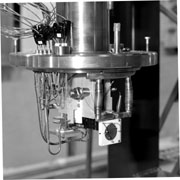 |

Right On Target Getting beam at fixed target areas has experimenters lining up their sights. by Mike Perricone Meanwhile, back at the Lab, the beam goes on. Beam is going to experiments, and experimenters are going to meetings. Through its External Beams Department, the Beams Division is sending a particle beam out to experimental areas for early work in the fixed target run. Ed Blucher and Bob Tschirhart are two of the experimenters getting in their early work each morning, attending a meeting held by the Beams Division. "Ed and I go to those 9 a.m. meetings every day, and everyone is very helpful," said Tschirhart, co-spokesperson with Blucher for KTeV (Kaons at the Tevatron). "Everyone has the common goal of getting the maximum performance from the beam." Early reports say the beam is performing well. "We’re really quite pleased with the way the accelerators have come up," said Craig Dukes, co-spokesperson for the HyperCP experiment, searching for CP violation in hyperon particles. "We’re looking forward to a very productive run." Beam is also running to the target area of the Antiproton Source—not yet for antiproton production, but for testing target prototypes for the long-baseline MINOS (Main Injector Neutrino Oscillation Search) experiment of NuMI (Neutrinos at the Main Injector). "We’re trying to choose the material and the configuration for the target," said NuMI/MINOS experimenter David Boehnlein. "We’re working with graphite and beryllium, testing the stresses when the beam strikes the target. We have to be sure the target can withstand those stresses." For Craig Moore, head of the External Beams Department, and Rick Coleman, the department’s fixed target coordinator, sending beam to fixed target experimenters is the harbinger of an entirely new routine with the Main Injector in operation. Replacing the old Main Ring, the Main Injector gives Fermilab the capability of running fixed target experiments simultaneously with collider experiments. So the fixed target program will not have to stop when Collider Run II of the Tevatron begins next year. "Actually, it will be even better for us," said Moore. "In the past, we had periods of intense activity and then periods where we weren’t sending beam to experiments." Moore and Coleman cited Walter Kissel of Operations, and beamline physicists Tom Kobilarcik and Rick Ford, for making the startup "unbelievably smooth." Sending beam to the fixed target areas begins at the DZero location of the Tevatron ring. Home to one of Fermilab’s two 5,000-ton collider detectors, DZero also houses an electrostatic septum (from the Latin saeptum, for partition). There, part of the beam is split off and sent on to the AZero location, where it meets an extraction magnet and is sent out toward the switchyard. The septa at the switchyard can then split the beam in as many portions as needed by the experiments; there were 10 experiments in the last fixed target run. The two kinds of septa, magnetic and electrostatic, operate on the same principle. A plane separates a field area from a non-field area, either a magnetic field or a stationary electric field. Circulating beam goes through the non-field area; extracted beam goes through the field area, which gives it a "kick" and changes its direction. The extraction magnets are called Lambertsons after their developer, accelerator physicist Glen Lambertson of Lawrence Berkeley National Laboratory, who has also conducted experiments at Fermilab. The beam is first magnetically distorted or "squeezed" to produce tendrils that resemble airplane propellers. The tendrils pass by the plane of wires (each roughly 10 feet long and only 50 microns, or millionths of a meter, wide). The electrostatic field kicks part of the beam into an extraction channel and on toward a Lambertson magnet. The process is identical to the resonant extraction process that served as the Main Injector’s final commissioning goal, and it will be used by the Main Injector to send beam to NuMI, KaMI (Kaons at the Main Injector, successor to KTeV) and other experiments. Experimenters now are "gearing up." At KTeV, where experimenters have seen direct CP violation in neutral kaons, the work focuses on calibrating their detectors for the next data-taking run. "Essentially, we throw out 99 percent of the kaon decays that occur inside the detector," Tschirhart explained. "To make sure we’re keeping all the good kaon decays, the detector has to be very well calibrated. If not, we’ll be throwing out good decays and not knowing it." HyperCP, examining hyperons (particles composed of three quarks, including one or more strange quarks) for CP violation, has a rebuilt spectrometer and trigger system to bring up to speed. "Basically, every component has changed, and timing is everything in this experiment," said Dukes. "We receive the beam in buckets that are 19 nanoseconds (billionths of a second) apart. If our trigger timing is sloppy, the next or previous bucket can affect what we’re trying to measure. We have to be pretty fastidious in our timing." For the NuMI target, which resembles a comb, the choice between graphite and beryllium hinges on which material can produce the highest yield of pions (which decay into neutrinos) from the smallest area. The proton beam will hit the center of the two-millimeter target, focused to within a few tenths of a millimeter. "We don’t know what these materials will do under high amounts of beam impact," said Jim Hylen, in charge of running the tests. "If one of the two materials can provide a very thin target that stands up to the very high intensities, that will be the one we select." |
| last modified 7/2/1999 email Fermilab |
FRLsDFx9eyfrPXgV